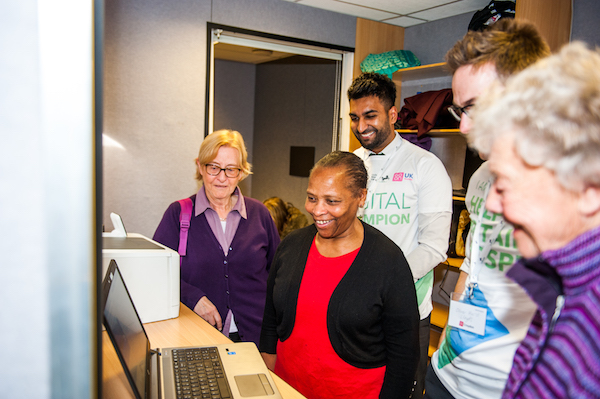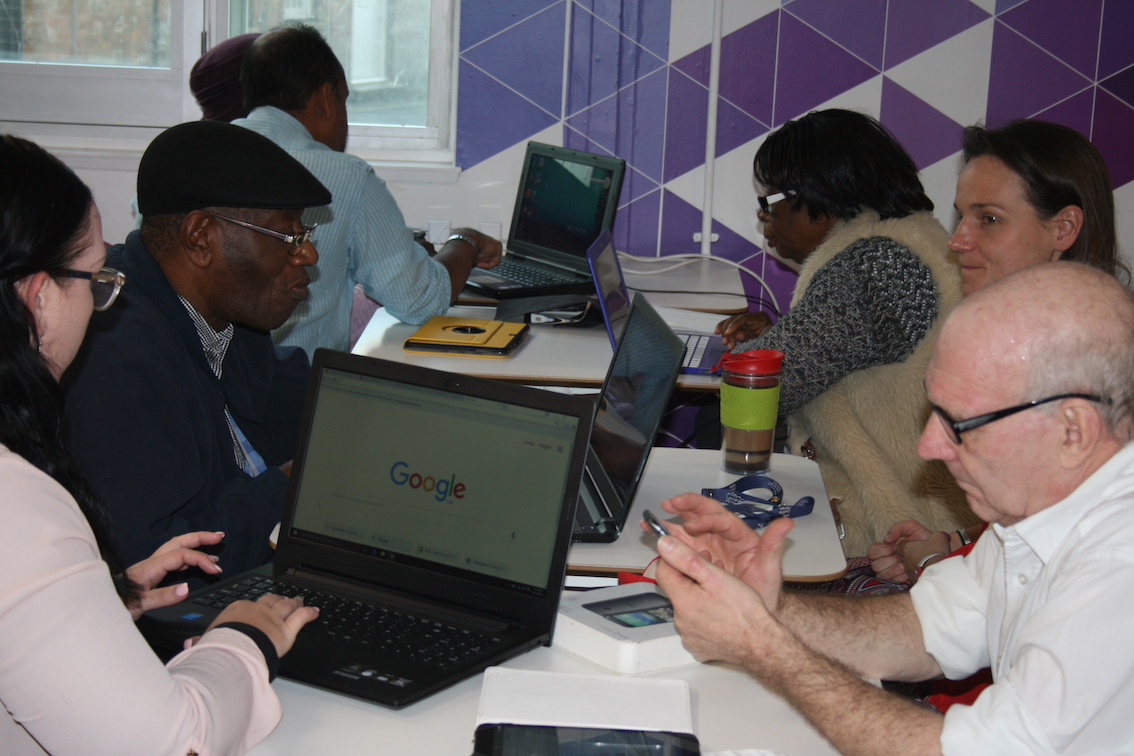By February 2017 we had reached over 7,500 people across both boroughs, with almost all our participants reporting improved basic digital skills and confidence. Gusto research funded by Lloyds Banking Group has shown that the number of people with basic digital skills in Croydon increased by 9%, and in Lewisham by 10%, during the pilot.
We have already seen that a small level of individual support or piece of equipment can often make all the difference and enable individuals, local communities and businesses to make real strides in learning digital skills.
[The session] helped me with my phobia about computers… My fear disappeared… With my new-found skills I can find my way around London.
The relaxed, friendly and informal atmosphere (as well as plenty of fuel in the form of tea, coffee and snacks)… makes the overall experience very enjoyable.
What worked well?

1. Using volunteer digital champions
We recruited volunteer digital champions from many of our partner organisations and other community groups. They delivered the Digital Zones and supported many of the Deep Dives and Community Engagement projects.
We didn’t prescribe what the digital champions had to do, allowing each project to be flexible in how they used them. Using friendly volunteers rather than formal teachers made residents feel more comfortable asking for help and took away some of the fear and stigma. Using local volunteers also gave the community a greater sense of ownership of the pilots, which helped increase the success of the projects.
Feedback from learners showed that three of the most important qualities for a successful digital champion were:
- the ability to communicate clearly and confidently
- the ability to build confidence by going at the learner’s pace and being patient and reassuring
- being ‘someone like me’ who learners could relate to
The digital champions themselves told us they enjoyed the opportunity to volunteer in their community and try something challenging and new.
I volunteered to become a digital champion because I had seen first-hand with older relatives how access to the internet opened up new worlds of information which kept them mentally and physically active, while online connectivity to family and friends allowed relationships across the generations to remain strong and reduced isolation and loneliness.
I have thoroughly enjoyed the sessions, meeting some wonderful residents and sharing their amazement and joy when they realised that, with just a few clicks of a mouse, they could skype their granddaughter in Canada or browse the wonderful show gardens at the Chelsea Flower Show.
2. Establishing face-to-face Digital Zones
The Digital Zones were extremely popular and by February 2017 had attracted almost 6,000 visitors. People liked the informality and flexibility that meant they could drop in to solve a one-off problem or attend regularly for a series of sessions.
But we found it a slow burn - it took time and effort to bring people into the zones, and much depended on word of mouth and natural footfall. Promotion was key and some zones were publicised more effectively than others.
We also hosted Digital Days in shopping areas, with pop-up Digital Zones and digital champions on hand to provide advice and support. These events helped to publicise the partner Digital Zones and increased the overall number of visitors.
3. Working with trusted, familiar partners
Using volunteer staff from well-known high-street organisations made learners more comfortable about asking for help. Trusted faces in local places creates familiarity and connection which helped residents more confidently take their first steps online. When residents were not only familiar with the brand, but also with the individual volunteer, this reduced the barrier to seeking help even further.
4. Understanding learners’ needs and motivations
Crucial to the project’s success was understanding the individual and often very personal needs and motivations of each learner. This requires patience and understanding and time to explain how using the internet can help someone do something they really care about - whether that’s following a hobby or contacting family and friends - or that they need to do - whether that’s applying for a job or accessing a service. Without this personal angle it can be very difficult to persuade people to go online for the first time.
5. Working towards a shared outcome
By using the Basic Digital Skills framework as the benchmark and a set of commonly agreed goals, all learners, volunteers and partners were working towards the same outcome. Even if the method of reaching that outcome varied from project to project and organisation to organisation, the end result was the same. This meant learners could choose the approach that worked best for them, monitor their progress and share a common way of describing the skills they learned.
What worked less well?

6. Projects with niche groups need co-design
In each Deep Dive we tried to reach a niche group who might have a very specific reason for not having digital skills.
Some of our projects didn’t work as we expected.
For example, we offered around 70 residents of a housing estate on the outskirts of Croydon free digital skills training and the chance to buy a tablet for £20, rather than the usual £90. Signing up also gave them access to a lower-cost broadband deal.
It seemed like a great offer. But we found it wasn’t taken up because taking the bus into central Croydon to get to where the training was offered required more effort from the residents than the perceived benefits. The residents were also suspicious of an offer that seemed too good to be true, presuming there had to be a catch.
We did not foresee these issues and this helped us realise the importance of designing the projects not just with our partners and specialist organisations, but also with the target group themselves in order to remove unexpected barriers.
7. Successful collaboration requires clear accountability
Through open dialogue and a spirit of shared endeavour we achieved some amazing outcomes.
For example, the Deep Dive in partnership with Crisis, EE / BT and Croydon Council to provide smartphones and training for a trial group of homeless people is showing how being connected can help to bring more order to what are often chaotic lives.
This will genuinely change my life for the better
If you’ve got a smartphone, you’re winning
Now I can see why everyone is into these b****y phones so much
This particular project has proved so popular that Crisis has a waiting list of members wanting to participate, which is extremely rare in their experience.
But managing a complex set of partner relationships and expectations is not easy. It’s essential to define clear roles and responsibilities from the outset and to hold partners to account for their commitments. This can be challenging when partners are donating time and resource pro bono. But without clear accountability, such a complex, multi-agency project can easily be derailed.
8. We had limited people resource
We wanted the organisations delivering the Deep Dives to take responsibility for their own projects in order to make them more sustainable and community-led. But sometimes we found ourselves getting pulled into day-to-day management and we did not have the resource to do this. It's important to find the right level of support for communities so that they have what they need to get up and running, but are self-sustaining for the future.
9. We didn't always get the data
In order to monitor progress we needed to know if the individual projects were achieving their expected outcomes, but we didn’t always get regular or consistent feedback - despite providing standard templates for partners to complete. This made it harder to evaluate success, and yet is critical to being able to adapt and change delivery for better outcomes.
10. Activities need constant promotion
To ensure the people we wanted to reach knew about the projects, it was crucial to publicise and promote them. But sustained promotion is costly and time-consuming and we could not promote the work as widely as we wanted.
Word-of-mouth from learners to other potential learners proved a valuable way of sharing information and credibility. Ensuring doctors’ surgeries, libraries and other community centres had leaflets and were aware of the work was also critical. But creating this ‘viral’ awareness of the project required a great deal of input from the local coordinators.
With more resources we could have promoted the projects more widely across the communities to increase engagement and participation.
Overall we learned some very valuable lessons:
- There’s no magic formula - people need a personal reason to learn something new. Find out how having basic digital skills can help each individual, and tailor the support accordingly. There’s no short cut.
- People learn best from informal, face-to-face encounters. Drop-in services with friendly, volunteer digital champions were popular and non-intimidating.
- Go hyperlocal because the ‘hard to reach’ really are hard to reach. Make it easy to reach your target group by being accessible in the places where they already go. Don’t expect them to seek you out.
- People respond well to ‘trusted faces in local places’. Learning from trusted people in familiar environments reduces stigma and fear and increases participation.
- Local partnerships with shared goals are vital. You need a broad network of public sector, private sector and not-for-profit sector partners on the ground, all working to the same outcomes to reach the range of people needed.
- Tell people, then tell them again. Projects need strong, local and visible promotion and regular events to maintain momentum.